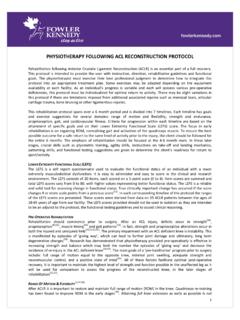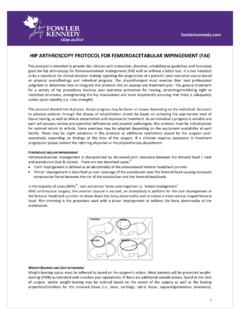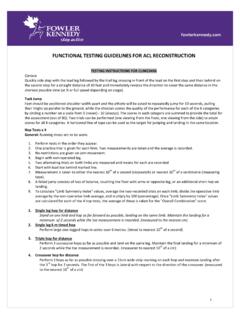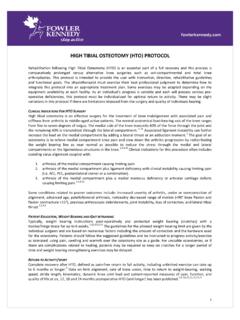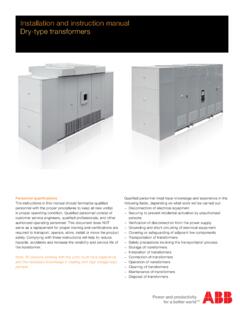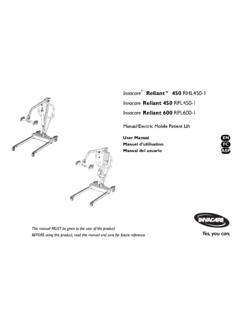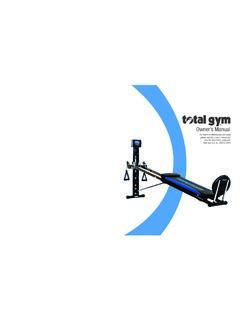Transcription of LARGE ROTATOR CUFF REPAIR PROTOCOL
1 LARGE ROTATOR cuff REPAIR PROTOCOL . The intent of this PROTOCOL is to provide the clinician with instruction, direction, rehabilitative guidelines and functional goals for all ROTATOR cuff REPAIR procedures. It is not intended to be a substitute for clinical decision- making regarding the progression of a patient's post-operative course based on physical exam/findings and individual progress. The physiotherapist must exercise their best professional judgment to determine how to integrate this PROTOCOL into an appropriate treatment plan. The general treatment for a variety of shoulder procedures involves protection of the REPAIR , stretching/mobilizing tight or restricted structures, strengthening the ROTATOR cuff and strengthening and retraining the scapular musculature. This particular PROTOCOL divided into 4 phases and the timeline can vary from 4 months to 1 year: Phase 1: Passive range of motion; Phase II: Active assisted active range of motion; Phase III: Resisted exercises/strengthening.
2 Phase IV: Advanced strengthening/dynamic stability. Therefore, decisions to advance patients through the phases of rehabilitation should be based on achieving the appropriate level of soft tissue healing, as well as clinical presentation and response to treatment. As an individual's progress is variable and each will possess various pre- operative deficiencies, this PROTOCOL must be individualized for optimal return to activity. Some exercises may be adapted depending on the equipment availability at each facility. There may be slight variations in this PROTOCOL or additional restrictions placed by the surgeon post-operatively depending on findings at the time of the surgery. If a clinician requires assistance in treatment progression please contact the referring physician or the physiotherapy department. 1. GENERAL CLASSIFICATION OF ROTATOR cuff TEAR SIZE.
3 Small: <1cm in length Medium: 1-3 cm LARGE : 3-5 cm Massive: >5 cm Also, tears are described as either partial or full thickness depending on the amount of tissue damage. Partial tears do not go all the way through the cuff , although a LARGE surface area may be involved either on the bursal side or, more commonly, on the articular side of the tendon(s). Full tears are completely through the tendon(s) (similar to a button-hole on a shirt) creating a gap/hole in the cuff . GENERAL CONSIDERATIONS FOR ROTATOR cuff REPAIR . 2. 1. Quality of tissue and integrity of REPAIR (stronger tissue if <50 years old). This includes the quality of the tendon, muscular tissue, and bone. Rehabilitation for the patient with good or adequate tissue would be a slightly more aggressive program, whereas the patient with poor tissue quality would follow a more conservative approach.
4 2. Acute vs. chronic tears/duration. Longer duration of symptoms has been correlated with histological changes 3. in the muscle that are often progressive and irreversible and potentially increase the difficulty of REPAIR . As a result, active ROM can be more difficult to achieve with chronic tears. 4. 3. Trauma vs. degenerative tear (traumatic tears tend to have better outcomes). 4. Tear size ( LARGE /massive tear or >1 tendon REPAIR difficult to achieve full ROM, caution with AROM and resisted 4. exercises with chronic/ LARGE tears). Functional outcome is directly related to size of the tear . Therefore, the rate of progression for post-surgical rehabilitation should vary based on the size and extent of the tear. The rate of progression following ROTATOR cuff REPAIR surgery is often determined by the amount of retraction present prior to REPAIR , with the more retracted tendon requiring a slower rehabilitation course because of a higher postoperative failure rate.
5 2. 5. First vs. revision surgery (revisions can be more prone to fibrosis and pain). 6. Use pain as in indicator of progression. Pain should decrease over time. 7. The early focus of physiotherapy is on achieving ROM before emphasizing strengthening. Early PROM of GH. joint is essential to prevent capsular adhesions and fibrosis. This is done with muscles in a shortened position. (Supraspinatus REPAIR : avoid passive IR, Hor Add, Ext. SubScapularis REPAIR : avoid passive ER, Hor Add, Ext). It 1. has be shown the greatest improvement in strength recovery are during the first 6 months after surgery but to 5, 6. reach near-maximum strength recovery it can take up to 1 year. Recovery of strength is correlated to tear size: a) small and medium tears strength recovery = almost complete during the first year, b) LARGE and 5. massive tears = much slower and less consistent.
6 STRESS/STRAIN AND ROM ON HEALING ROTATOR cuff TISSUE. 7. Tendon-to-bone healing is slow after injury/surgery as tendons have lower oxygen uptake than skeletal muscle . It has been shown in animal studies that healing begins with the formation of a fibro-vascular tissue interface 8, 9 10. between tendon and bone. The bone grows into the interface tissue and gradually, collagen fibre continuity is 11. created between the tendon and bone . It requires at least 12 weeks of healing to allow adequate pull-out 12. strength of the REPAIR . As a result, strengthening should be postponed until this general timeline. Following ROTATOR cuff REPAIR surgery, a post-operative abduction pillow brace supporting the shoulder >30 . abduction is used, for a minimum of 2-6 weeks, as there is documented evidence that there is less strain on the 13. repaired supraspinatus tendon in that range vs.
7 Arm at side. Furthermore, strain is lowest in the scapular and 13. coronal plane vs. the sagittal plane. Generally, passive external rotation is restricted to 60 with the arm at >30 . elevation in the scapular or coronal plane to avoid excessive tension on the REPAIR . Since active and passive ROM. exercises can significantly increase strain on the REPAIR site, they should be used with caution in certain ranges on a healing ROTATOR cuff . LARGE tears that extend into the posterior cuff (infraspinatus and teres minor) require greater protection and excessive internal rotation should be restricted. With these tears, external rotation strengthening should be progressed at a slower rate. Initiating ROTATOR cuff and scapula stabilization strengthening exercises should be approached with caution to prevent stress applied to the healing tissues.
8 Stress applied too early or too aggressively could lead to gap formation, pain, and re-tearing of the REPAIR . When appropriate, sub maximal and pain-free multiangle isometrics for ER and IR should be performed to prevent muscular atrophy and to minimize ROTATOR cuff inhibition. ROLE OF THE ROTATOR cuff . The main role of the ROTATOR cuff is to centralize and compress the humeral head in the glenoid fossa to maintain the instantaneous centre of rotation of the glenohumeral joint during arm movement. To be effective there must be an equal anterior/posterior balance ROTATOR cuff (subscapularis = infraspinatus+teres minor) as well as an equal superior/inferior balance between the entire cuff and the deltoid muscles (subscapularis+infraspinatus+teres minor = deltoid). If one part of the cuff is torn/deficient an imbalance will result and the translatory force of the deltoid will pull the humerus in a superior direction up under the acromion leading to mechanical impingement.
9 Exercises that produce the most supraspinatus and least deltoid activity may avoid potential deleterious superior humeral head migration associated with high deltoid activity. Restoration of these force couples is vital at the appropriate time in ROTATOR cuff rehabilitation. SCAPULAR MOVEMENT. The scapula moves around three axes and has six movements: up/downward rotation, internal/external rotation, anterior/posterior tipping through muscle control. (protraction/retraction refers to movement around the thorax). 0. With the arm at side, the glenoid fossa is tilted 5 into upward rotation. At 90 of abduction the glenoid fossa is tilted enough to provide a stable platform to prevent inferior translation. In full abduction, the glenoid fossa is in 14, 15. upward rotation, external rotation and posterior tilt. Subjects with shoulder pain have been shown to lack 16, 17.
10 Upward rotation and posterior tilt resulting in less clearance space for the ROTATOR duff during elevation. Restoration of upward rotation and posterior tilt is important to establish in ROTATOR cuff rehabilitation to establish proper overhead mechanics. SCAPULAR FORCE COUPLES. There is a moving axis of rotation that commences at the root of the spine of the scapula on initiation of movement and travels along the spine of the scapula to the AC joint at the end range of elevation and abduction. 2. The main muscles that control scapular movement are trapezius, serratus anterior, rhomboids, levator scapula and pectoralis minor (see chart below). The most influential force couple that acts to upwardly rotate the scapula (glenoid fossa) is the trapezius (upper and lower fibres) and serratus anterior. From a pathology standpoint, this force couple is often the problem source and can become dyskinetic during either/both concentric or eccentric 18.
